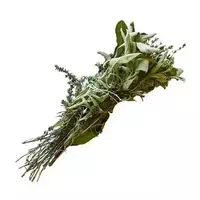Garni bouquet

A bouquet of garni. . . Surely for some this phrase is associated with witchcraft recipes, magic tales or cozy cuisines of the world. For those who have never tried or even seen this miracle, it will be interesting to know that the garni bouquet is a bouquet of fragrant spicy herbs, both dry and fresh. They are carefully wrapped in laurel leaves and tied with a culinary thread. Often, instead of a thread, herbs are wrapped in a small bag made of cotton fabric.
Basically, it is customary to add a bouquet of garni to a variety of dishes to improve their taste and aromatic characteristics. As a rule, these are broths and soups, but often you can add these herbs to other dishes. This is something like how laurel leaves were added from time immemorial in our country, so in Europe it is customary to use a small bouquet of different leaves.
A bouquet of garni is common in southern France, in particular in Provence. The first bouquets were created by French culinary experts - this is a tradition of the country, but, which is especially gratifying, today it is known to almost every European hostess, while the name itself is an accepted term.
The interesting thing is that a small and large bouquet of garni stands out. The first option necessarily includes bay leaf, parsley, celery and thyme. A large bouquet of garni consists of the above spicy herbs, which are complemented by basil, tarragon, char, majorán, chervel, rosemary and pimpinella.
By the way, there is also a so-called medium bouquet of garni - when 2-4 spicy herbs from a large one are included in the permanent set of a small bouquet, if desired, depending on the nature of the first dish (vegetable, meat, fish or chicken). In addition, you can use a set of peppers (black, red, white and fragrant). Components are added at the discretion of the cook: for example, someone does not represent ears without dill, and some other dishes - without oregano or tarhun.
It is noteworthy that the consistency of the dish in which the garni bouquet is laid does not matter at all. In equal measure, a rich aroma manifests itself in marinades, light or strong broths, thick soups, sauces or even when smoking fish. Using a bouquet of garni is quite simple - you need to lower it into a boiling broth a couple of minutes before turning off the fire, and then remove it.
By the way, a distinctive property of this seasoning is its repeated use - you can add a bouquet of garni after drying up up to three times. In the first use, the holding time is about one and a half minutes, while when immersed again, the frames increase by half a minute. In the third application, the optimal time is considered to be exactly three minutes.
The garni bouquet is a constant figure in ancient recipes and culinary advice. This is a kind of detail with which you can change a lot - for example, make the usual and slightly annoying sauce simply extraordinary. At the same time, a bouquet of garni is a purely individual creation and at the same time you need to be able to make it correctly. It is not enough to bind several sprigs of different herbs into a bunch - it is necessary to calculate exactly how much and what greens will be needed based on its aromatic and taste qualities. Ideally, a harmonious composition is obtained, all the smells in which perfectly complement each other and at the same time none is at the head.
259 kCal garni bouquet
The energy value of a bouquet of garni (Ratio of proteins, fats, carbohydrates - ju):
Proteins: 12.4 g (~ 50 kCal)
Fats: 6.5 g (~ 59 kCal)
Carbohydrates: 26g (~ 104kCal)
Energy ratio (b | y): 19% | 23% | 40%
 Español
Español Français
Français Português
Português Русский
Русский 简体中文
简体中文 繁體中文
繁體中文 日本語
日本語 한국어
한국어 العربية
العربية Türkçe
Türkçe Қазақ
Қазақ Deutsch
Deutsch Italiano
Italiano Українська
Українська
